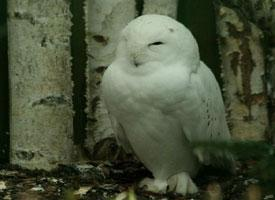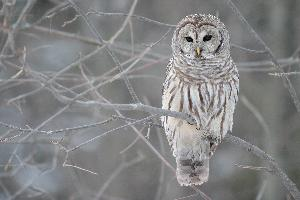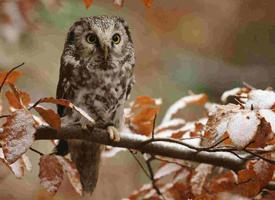
Connu aussi comme
- Sovice sněžná
Poids et mesures
| Longueur | 60 cm |
|---|---|
| Poids | de 1,35 à 2,6 kg |
| Envergure des ailes | 160 cm |
Statut de conservation
| Menacé |
Description de l'animal
The Snowy Owl (Bubo scandiacus) is a majestic and captivating bird species, renowned for its striking white plumage that beautifully camouflages it against the snowy landscapes of the Arctic regions it calls home. This large owl belongs to the family Strigidae and is one of the most distinctive and easily recognizable of all owl species, primarily due to its unique appearance and the extreme environments it inhabits.Adult Snowy Owls are large birds, with females typically larger than males, a common trait among owl species. They have rounded heads without ear tufts, and their eyes are a striking yellow, offering a sharp contrast to their predominantly white feathers. Males are usually whiter than females, which display more black flecks and bars across their body and wings. This dimorphism is not just for beauty; it plays a crucial role in their survival and breeding behaviors.
One of the most remarkable features of the Snowy Owl is its adaptation to the Arctic life. These birds are diurnal, meaning they are active during the day, which is a necessity in an environment where summer days are long and nights are virtually nonexistent. Their bodies are well-insulated with dense feathering, which keeps them warm in the bitterly cold temperatures of their habitat. Even their feet are feathered, acting as natural snowshoes.
Snowy Owls are primarily found in the circumpolar regions of the northern hemisphere. They breed on the Arctic tundra, where their nests are simple depressions in the ground. Their range can vary greatly depending on the season and the availability of prey. In winter, some migrate southward, reaching as far as the northern United States, while others remain in their Arctic breeding grounds year-round.
These owls are formidable predators with a diet that mainly consists of small mammals. Lemmings are a staple in their diet, and the abundance or scarcity of these rodents can significantly affect Snowy Owl populations. They are also known to hunt other small mammals, as well as birds, depending on the availability of prey.
Snowy Owls have keen eyesight and hearing, which they rely on to detect and capture prey under the snow or in the air. They hunt primarily from a perch but can also catch birds in flight. Their flight is powerful and direct, with deep wingbeats that are characteristic of larger owl species.
In terms of behavior, Snowy Owls are solitary and territorial, especially during the breeding season. Males perform elaborate flight displays to attract females and are fiercely protective of their nesting sites. After mating, females lay a clutch of 3-11 eggs, with the number often depending on the availability of food. Both parents take part in raising the young, which are born helpless and rely on their parents for warmth, protection, and food.
Conservation-wise, the Snowy Owl is currently listed as a species of least concern by the International Union for Conservation of Nature (IUCN), although it faces threats from climate change, which impacts its Arctic habitat and prey availability. Additionally, human activities such as aviation pose significant risks, with Snowy Owls often colliding with aircraft.
The Snowy Owl holds a special place in the folklore and cultures of indigenous Arctic peoples, symbolizing wisdom and foresight. It has also captured the imagination of the wider world, appearing in literature, film, and art, and remains one of the most iconic and admired bird species globally.
Carte de répartition

Animaux similaires
Nouvelles photos d'animaux
Top 10 des animaux
- Dolphin gull (Leucophaeus scoresbii)
- Diana monkey (Cercopithecus diana)
- Moustached guenon (Cercopithecus cephus)
- Galápagos tortoise (Geochelone nigra complex)
- Stone loach (Barbatula barbatula)
- Japanese macaque (Macaca fuscata)
- Russian tortoise (Testudo horsfieldii)
- Greek tortoise (Testudo graeca)
- Common flying dragon (Draco volans)
- Vendace (Coregonus albula)


